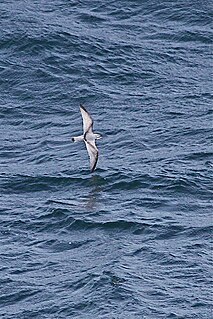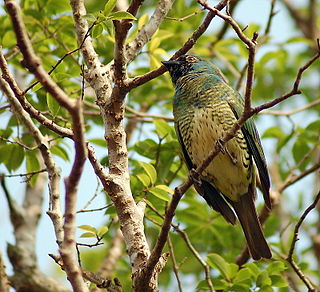
Pachyptila is a genus of seabirds in the family Procellariidae and the order Procellariiformes. The members of this genus and the blue petrel form a sub-group called prions. They range throughout the southern hemisphere, often in the much cooler higher latitudes. Three species, the broad-billed prion, the Antarctic prion and the fairy prion, range into the subtropics.

The spotted sandpiper is a small shorebird. Together with its sister species the common sandpiper, it makes up the genus Actitis. They replace each other geographically; stray birds may settle down with breeders of the other species and hybridize.

The common sandpiper is a small Palearctic wader. This bird and its American sister species, the spotted sandpiper, make up the genus Actitis. They are parapatric and replace each other geographically; stray birds of either species may settle down with breeders of the other and hybridize. Hybridization has also been reported between the common sandpiper and the green sandpiper, a basal species of the closely related shank genus Tringa.

The Eurasian stone-curlew, Eurasian thick-knee, or simply stone-curlew is a northern species of the Burhinidae (stone-curlew) bird family.

Karl Christian Friedrich Krause was a German philosopher whose doctrines became known as Krausism. Krausism, when considered in its totality as a complete, stand-alone philosophical system, had only a small following in Germany, France, and Belgium, in contradistinction to certain other philosophical systems that had a much larger following in Europe at that time. However, Krausism became very popular and influential in Restoration Spain not as a complete, comprehensive philosophical system per se, but as a broad cultural movement. In Spain, Krausism was known as "Krausismo", and Krausists were known as "Krausistas". Outside of Spain, the Spanish Krausist cultural movement was referred to as Spanish Krausism.
Johann Karl Wilhelm Illiger was a German entomologist and zoologist.

Johann Centurius Hoffmann Graf von Hoffmannsegg was a German botanist, entomologist and ornithologist. The standard author abbreviation Hoffmanns. is used to indicate this person as the author when citing a botanical name.

Neotropical bellbird is the common name given to passerine birds of the genus Procnias, found in the Neotropics. They are members of the cotinga family. They are all restricted to tropical or subtropical humid forested regions, often in low mountains or foothills. As indicated by their common name, they all have extremely loud calls that are reminiscent of a metal bell being rung.

The double-striped thick-knee is a stone-curlew, a group of waders in the family Burhinidae. The vernacular name refers to the prominent joints in the long greenish-grey legs, and bistriatus to the two stripes of the head pattern.

{{Infobox artist

Actitis is a small genus of waders, comprising just two very similar bird species.

The fairy prion is a small seabird with the standard prion plumage of blue-grey upperparts with a prominent dark "M" marking and white underneath. The sexes are alike. This is a small prion of the low subantarctic and subtropic seas.

The swallow tanager is a species of Neotropic bird in the tanager family Thraupidae. It is the only member of the genus Tersina. It is found widely throughout South America, from eastern Panama to far northern Argentina. The species is sexually dimorphic: the female is a yellow-green and the male a turquoise blue with a small deep black face and upper throat patch.

The Peruvian thick-knee is a species of bird in the family Burhinidae. It is found in Chile, Ecuador, and Peru. Its natural habitats are subtropical or tropical dry shrubland, subtropical or tropical seasonally wet or flooded lowland grassland, and pastureland. It is a ground-dwelling bird and feeds on insects and small animals.

Herpestes is a genus within the mongoose family Herpestidae. Several species in the family are known as slender mongooses. It is the type genus of the family, and comprises 5-6 living species, each with several subspecies. Fossil remains of three prehistoric species were excavated in France, and described in 1853.

The Indian stone-curlew or Indian thick-knee is a species of bird in the family Burhinidae. It was formerly included as a subspecies of the Eurasian stone-curlew. This species is found in the plains of South and South-eastern Asia. They have large eyes and are brown with streaks and pale marks making it hard to spot against the background of soils and rocks. Mostly active in the dark, they produce calls similar to the true curlews, giving them their names.
In zoology, the principle of homonymy is one of the guiding principles of the International Code of Zoological Nomenclature.
Ongoing events Alexander Wilson Ornithology of America (1808–1814) Species described in 1810 include the American tree sparrow, the pine siskin, the blue-headed vireo, the mourning warbler and the marsh wren.

Eumolpus is a genus of leaf beetles in the subfamily Eumolpinae. It includes 40 species, most of which have a large size and include some of the largest members of the subfamily. They are distributed throughout the Neotropical realm, though one species has been recorded as far north as Arizona, and the genus is not found in the Caribbean.
Hydrovatus lyratus, is a species of predaceous diving beetle widespread in South Asia, South East Asia and Australian region.
















